

|
Back to |
| The Front Page |
| News & Features |

| Croquet on Zambonied Ice | ||||||
|
by Bob Alman photos courtesy of Ron Eccles Posted January 31, 2012
|
||||||
|
||||||
It lasts only a few months at most, but if you must play croquet at the frozen peak of a winter season, you can now get the equipment you need, and if you're fortunate, you can find a proper ice court--one that has been Zambonied. Hockey fans will know that the Zambonie is a machine the size of a small car that shaves natural ice smooth and then tops it with a thin layer of water which freezes in place to produce a perfectly flat and very slick surface, upon which a game can be played. Hockey or croquet? Take your pick.
It seemed a perfectly reasonable thing for members of the Minneapolis Croquet Club to consider, when everything froze over in Minnesota. So Todd McGonagle, Dr. Richard Sheely, and Ron Eccles started talking about how they could get it done. Almost predictably, actually getting it done took longer than they thought it would, but once the kinks were ironed out, the game of Ice Croquet turned out not only to be feasible but rather fun.
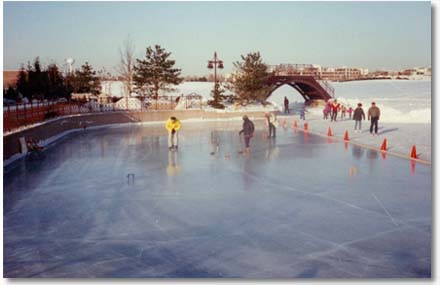
|
| Ron Eccles (in the yellow jacket) goes for penultimate in the regular Saturday morning games at Centennial Lakes. |
Ron was president of the Minneapolis Croquet Club, and "home ice" to that club turned out to be nearby Centennial Lake in the town of Edina, on ice Zambonied for winter sports by the park authority.

|
| Jeff Maxwell and Ron Eccles wait for Rick Sheely to finish his turn on the ice in Edina, Minnesota. |
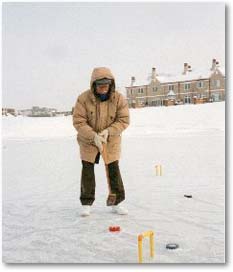
|
| Osman Elhadary, who has written several books on croquet in Arabic, finds the ice surface in Minnesota very different from croquet courts in his native Egypt. |
The pucks resemble hockey pucks, but are manufacturered in the same diameter and weight as the standard croquet ball and of a similar similar compound with equivalent bounce characteristics. According to Eccles, "It's great fun to see the instant transfer of energy on roquets, and when there's been a light dusting of snow, the puck leaves a path that you can clearly see. You can see lines of all shots from hitting another puck, and on split shots you'll see the two tracks."
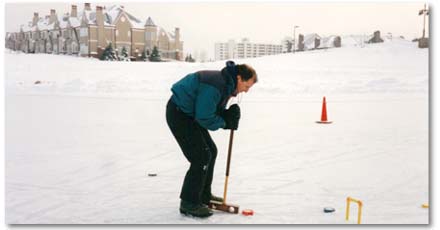
|
| Rick Sheely goes for an angled hoop. |
The equipment doesn't allow jump shots, "but all the others are exactly the same as a regular ball, including pass rolls," says Eccles.
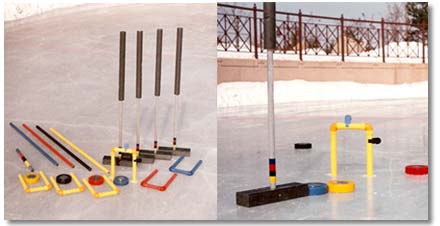
|
String lines are used for boundaries, anchored in holes drilled in the ice.
The rules USCA members play are a combination of Association Croquet and American Rules. "We use AC rules for deadness and starting," Eccles says. "A puck touching the string is out and comes into the court a mallet head. We have clamp clips and we made special mallets, but any mallet can be used. We don't recommend wooden heads, though, because the water raises bad results on the wood."
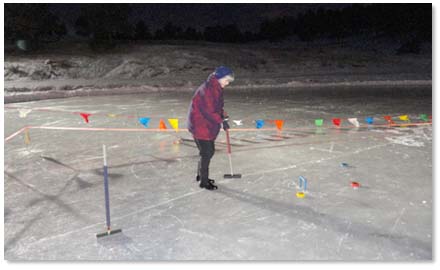
|
| In Evergreen, Colorado, Judy McKeon eyes a shot on the biggest expanse of natural Zambonied ice in the world. |
The court size Eccles recommends for Ice Croquet is 40 feet by 60 feet, on the standard 6-hoop layout. For corporate and private parties playing as novices, Golf Croquet is almost always the game of choice.
Ron Eccles is the president of the Denver Croquet Club and produces Ice Croquet and conventional croquet events as Croquet Marketing of America, which manufactures the special equipment used for Ice Croquet. Contact him at 720-937-2056, or by email at rontseg@comcast.net.